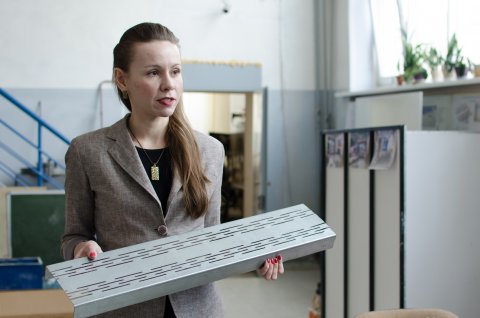Energy- and resource-preservation is one of the main directions of research in both modern science as a whole and at the University. It is also significant for the construction industry.
Candidate of technical sciences, assistant professor of the SUSU Institute of Architecture and Building's Department of Construction Manufacturing and Structural Theory Natalya Degtyaryova talked about this with us.
“My area of scientific interests is tied to the research of the work of light thin-walled steel constructions, especially thermoprofiles – constructions with walls that have perforations like a punch card, laid out like a checkerboard,” says the researcher. “They are used around the world in construction and reconstruction of buildings and structures. The use of thermoprofiles allows for the thermotechnical characteristics of enclosed structures to be improved.”
As the researcher explains, thanks to these perforations it is possible to lower thermal conductivity approximately to the level of wooden constructions.
“The thing is that although thermoprofiles are used all around the world, including in Russia, normative documentation which would regulate the calculation of constructions with this kind of perforation are not developed. Therefore we decided to work on research in this area,” adds Natalya Vladimirovna.
In 2013, the topic “Experimental and theoretical research on thermoprofile’s strength against cutting and development of recommendations for calculations” was included in the research plan of the Russian Academy of Architectural and Construction Sciences, which also financed this work. As a result, 25 cross section beams were tested against cutting. The testing was completed on the Tinius Olsen machine in the laboratory of the Construction academic research center of the Institute of Architecture and Construction. Beams for testing were provided by ZAO INSI, whose manufacturing is located in Chelyabinsk.

“While completing this work we applied two approaches: experimental research and theoretical research based on a finite-element model created in the ANSYS software suite which can be accessed in the SUSU Supercomputer Modeling Laboratory. Through this work, we were able to create a computer model which matched the testing results with high accuracy. Two articles were published per the results of experimental and theoretical investigation in a field-specific journal, Thin-Walled Structures, which is indexed in the Scopus database, and a presentation was given at an international conference held in Baltimore (USA). It makes me happy that the university supports such research and stimulates these publications both morally and materially – this is a sign of the recognition of their importance,” says Natalya Degtyaryova.
The publications were completed with a co-author, Natalya’s brother Vitaliy Degtyaryov, who graduated from the SUSU Faculty of Architecture and Construction in 1998, defended his candidate’s dissertation, and is currently working in the USA in the company New Millennium Building Systems. Natalya’s brother also recommended that she work on this topic, helped her complete the experiments, and helped write the article.
At this time, Natalya Vladimirovna is continuing to work in this area: she is researching the sturdiness and durability of thermoprofiles under bending. In the previous year, she participated in the Supporting Young Science contest in the engineering category with the topic “Development of a high-accuracy finite-element model of thermoprofiles and study of the effect of wall perforations on their sturdiness and durability under bending.” In December the young scientists who won the contest, including Natalya Degtyaryova, were recognized in the SUSU Pushkin Hall. The awards were given out by the vice rector of informatization Leonid Sokolinskiy.
“What does publication in highly-rated international scientific journals give? Recognition in scientific circles, the possibility of gaining research and business contacts in Russia and abroad, and finding like-minded people. It is difficult to publish an article in a highly-rated journal. But if you study the problem you’re working on from all sides, read publications by different authors, including foreign authors, in English – that is, you work on your topic systematically – then you’ll definitely have success!”




